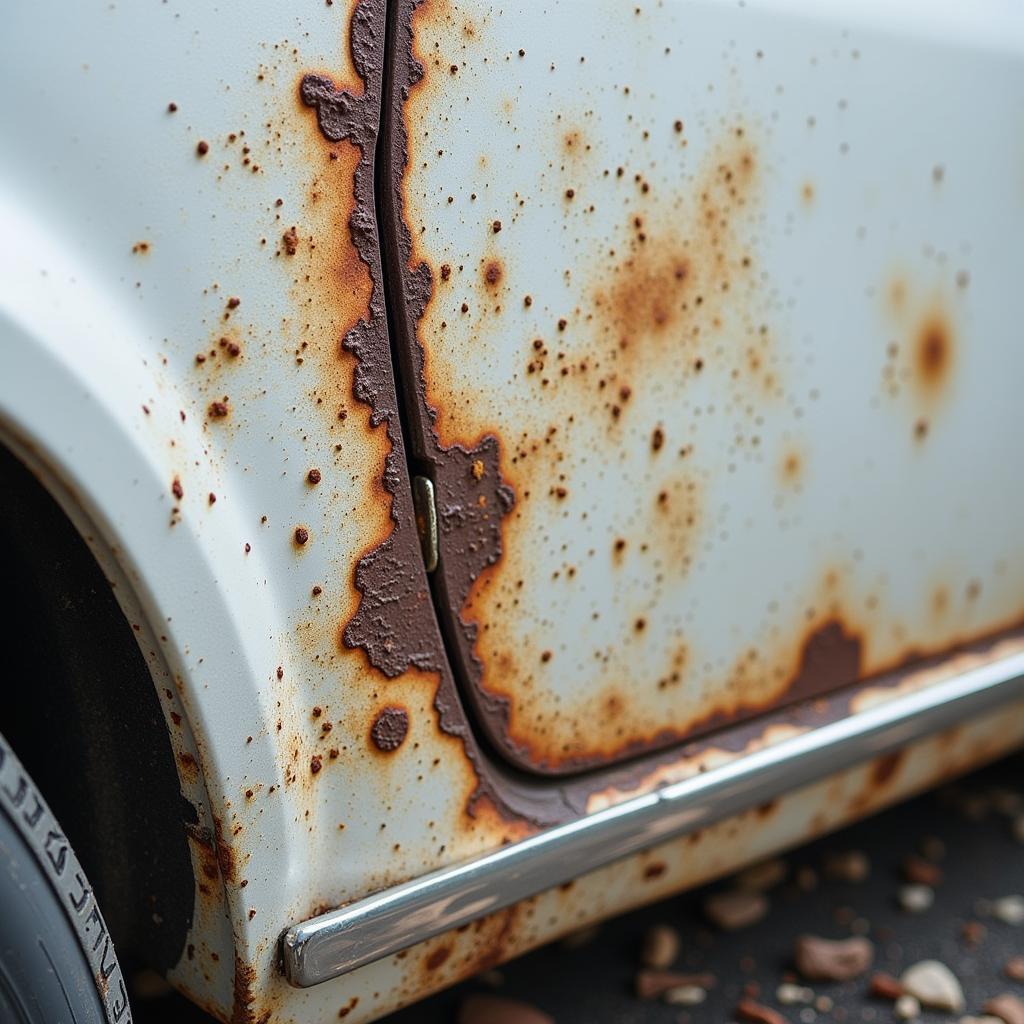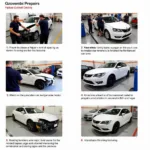Rust on your car’s paint is a common problem that can quickly escalate if left untreated. It not only detracts from your car’s appearance but can also lead to serious structural damage. Knowing how to repair rust on car paint is essential for maintaining your vehicle’s value and longevity. This guide will provide a comprehensive walkthrough of the process, from identifying the problem to preventing future rust formation.
Repairing rust on car paint requires more than just a quick fix; it involves understanding the underlying causes and addressing them effectively. Minor surface rust might be tackled with DIY methods, but deeper corrosion often requires professional intervention. Choosing the right approach depends on the severity of the rust and your level of experience. Let’s delve deeper into the effective techniques for tackling this common car problem. See repair car paint chips rust for more information about repairing paint chips that have started to rust.
Assessing the Rust Damage
Before you begin, it’s crucial to assess the extent of the rust damage. Is it surface rust or has it penetrated deeper layers of the metal? Surface rust appears as small, reddish-brown spots and can often be removed with relatively simple methods. Deeper rust, however, requires more extensive repairs. Look for bubbling or flaking paint, which indicates that the rust has spread beneath the surface.
What are the signs of rust damage on car paint? Look for bubbling paint, flaking, and reddish-brown discoloration.
Gathering Your Supplies
Once you’ve assessed the damage, gather the necessary supplies. For surface rust, you’ll need sandpaper (varying grits), rust converter, primer, paint that matches your car’s color, clear coat, masking tape, and a few clean cloths. For deeper rust, you may also need a wire brush, body filler, and possibly a grinding tool. Having the right tools on hand makes the repair process much smoother.
What tools are needed to repair rust on car paint? Essential tools include sandpaper, rust converter, primer, paint, clear coat, and masking tape.
Step-by-Step Rust Repair Guide
-
Prepare the Area: Clean the rusted area thoroughly with soap and water, then dry completely. Mask off the surrounding area to protect the undamaged paint. Proper preparation is key to a successful repair.
-
Remove the Rust: For surface rust, use sandpaper to remove the rust until you reach bare metal. For deeper rust, use a wire brush or grinding tool to remove all traces of rust and loose paint.
-
Apply Rust Converter: Apply a rust converter to the affected area, following the manufacturer’s instructions. This chemically converts the rust into a stable compound, preventing further corrosion.
-
Apply Body Filler (If Necessary): If the rust has caused pitting or unevenness in the metal, apply body filler to smooth the surface. Sand the filler smooth once it dries.
-
Prime the Area: Apply a thin, even coat of automotive primer to the repaired area. Primer provides a good surface for the paint to adhere to.
-
Paint and Clear Coat: Apply several thin coats of paint that matches your car’s color, allowing each coat to dry before applying the next. Finish with a clear coat to protect the paint and give it a glossy finish. See how to repair rusted paint chips on car for detailed instructions on repairing rusted paint chips.
Preventing Future Rust
Preventing rust is easier than repairing it. Regularly washing and waxing your car can help protect the paint and prevent rust formation. Addressing minor paint chips promptly can also prevent rust from taking hold. Consider car paint small chip rust repair for addressing small rust spots caused by paint chips.
How can I prevent rust on my car’s paint? Regular washing, waxing, and promptly addressing paint chips are key to rust prevention.
Conclusion
Repairing rust on car paint is a manageable task, especially if caught early. By following the steps outlined in this guide and understanding the importance of prevention, you can keep your car looking its best and prevent costly repairs down the road. Remember to assess the damage accurately and use the appropriate techniques for effective rust removal and repair. Addressing rust promptly not only enhances your car’s appearance but also protects its structural integrity. You can find additional information on repairing rusted car paint patches at rust patch paint repair car. For a comprehensive guide on painting over repaired rust areas, see painting car rust repair.
FAQ
-
What causes rust on car paint?
Rust is caused by the oxidation of iron in the presence of moisture and oxygen. -
Can I repair rust myself?
Yes, minor surface rust can often be repaired with DIY methods. -
How long does rust repair take?
The time required depends on the severity of the rust. -
What type of paint should I use for rust repair?
Use automotive paint that matches your car’s color. -
How can I prevent rust from returning?
Regular washing, waxing, and addressing paint chips promptly are key to prevention. -
What if the rust is very deep?
Deep rust may require professional repair. -
Can I use household cleaners to clean the rusted area?
Use automotive cleaning products specifically designed for this purpose.
Common Rust Repair Scenarios
- Small Rust Spots: Treat these with sandpaper, rust converter, and touch-up paint.
- Bubbling Paint: This indicates deeper rust and requires more extensive repair.
- Rust on Wheel Wells: This area is particularly prone to rust due to exposure to road debris and moisture.
Further Reading and Resources
For more in-depth information, check out our other articles on car maintenance and repair.
Need professional help? Contact us via WhatsApp: +1(641)206-8880 or Email: [email protected]. Our 24/7 customer support team is ready to assist you.


